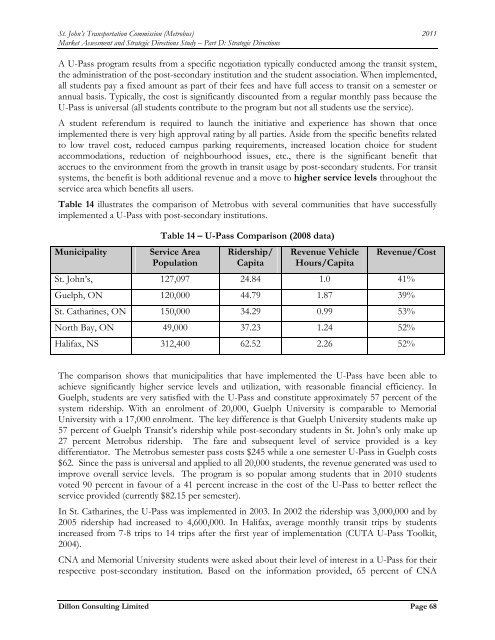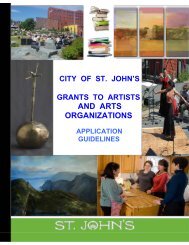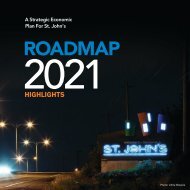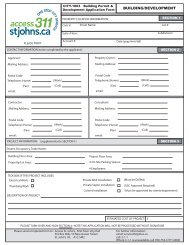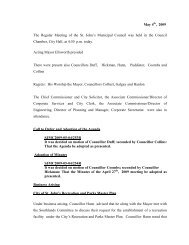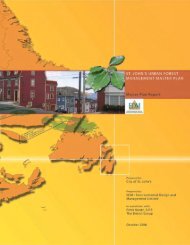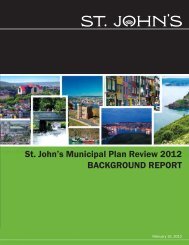Metrobus Transit Study.pdf - City of St. John's
Metrobus Transit Study.pdf - City of St. John's
Metrobus Transit Study.pdf - City of St. John's
Create successful ePaper yourself
Turn your PDF publications into a flip-book with our unique Google optimized e-Paper software.
<strong>St</strong>. John’s Transportation Commission (<strong>Metrobus</strong>) 2011<br />
Market Assessment and <strong>St</strong>rategic Directions <strong><strong>St</strong>udy</strong> – Part D: <strong>St</strong>rategic Directions<br />
A U-Pass program results from a specific negotiation typically conducted among the transit system,<br />
the administration <strong>of</strong> the post-secondary institution and the student association. When implemented,<br />
all students pay a fixed amount as part <strong>of</strong> their fees and have full access to transit on a semester or<br />
annual basis. Typically, the cost is significantly discounted from a regular monthly pass because the<br />
U-Pass is universal (all students contribute to the program but not all students use the service).<br />
A student referendum is required to launch the initiative and experience has shown that once<br />
implemented there is very high approval rating by all parties. Aside from the specific benefits related<br />
to low travel cost, reduced campus parking requirements, increased location choice for student<br />
accommodations, reduction <strong>of</strong> neighbourhood issues, etc., there is the significant benefit that<br />
accrues to the environment from the growth in transit usage by post-secondary students. For transit<br />
systems, the benefit is both additional revenue and a move to higher service levels throughout the<br />
service area which benefits all users.<br />
Table 14 illustrates the comparison <strong>of</strong> <strong>Metrobus</strong> with several communities that have successfully<br />
implemented a U-Pass with post-secondary institutions.<br />
Municipality<br />
Table 14 – U-Pass Comparison (2008 data)<br />
Service Area<br />
Population<br />
Ridership/<br />
Capita<br />
Revenue Vehicle<br />
Hours/Capita<br />
Revenue/Cost<br />
<strong>St</strong>. John’s, 127,097 24.84 1.0 41%<br />
Guelph, ON 120,000 44.79 1.87 39%<br />
<strong>St</strong>. Catharines, ON 150,000 34.29 0.99 53%<br />
North Bay, ON 49,000 37.23 1.24 52%<br />
Halifax, NS 312,400 62.52 2.26 52%<br />
The comparison shows that municipalities that have implemented the U-Pass have been able to<br />
achieve significantly higher service levels and utilization, with reasonable financial efficiency. In<br />
Guelph, students are very satisfied with the U-Pass and constitute approximately 57 percent <strong>of</strong> the<br />
system ridership. With an enrolment <strong>of</strong> 20,000, Guelph University is comparable to Memorial<br />
University with a 17,000 enrolment. The key difference is that Guelph University students make up<br />
57 percent <strong>of</strong> Guelph <strong>Transit</strong>’s ridership while post-secondary students in <strong>St</strong>. John’s only make up<br />
27 percent <strong>Metrobus</strong> ridership. The fare and subsequent level <strong>of</strong> service provided is a key<br />
differentiator. The <strong>Metrobus</strong> semester pass costs $245 while a one semester U-Pass in Guelph costs<br />
$62. Since the pass is universal and applied to all 20,000 students, the revenue generated was used to<br />
improve overall service levels. The program is so popular among students that in 2010 students<br />
voted 90 percent in favour <strong>of</strong> a 41 percent increase in the cost <strong>of</strong> the U-Pass to better reflect the<br />
service provided (currently $82.15 per semester).<br />
In <strong>St</strong>. Catharines, the U-Pass was implemented in 2003. In 2002 the ridership was 3,000,000 and by<br />
2005 ridership had increased to 4,600,000. In Halifax, average monthly transit trips by students<br />
increased from 7-8 trips to 14 trips after the first year <strong>of</strong> implementation (CUTA U-Pass Toolkit,<br />
2004).<br />
CNA and Memorial University students were asked about their level <strong>of</strong> interest in a U-Pass for their<br />
respective post-secondary institution. Based on the information provided, 65 percent <strong>of</strong> CNA<br />
Dillon Consulting Limited Page 68


